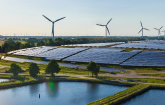
Latest report indicates a mixed solar market, offers insight into future of the industry post-One Big Beautiful Bill Act
BOSTON, Sept. 3, 2025 /PRNewswire/ -- The residential solar market in the United States experienced an uneven start to 2025, according to 21st EnergySage Intel: Solar & Storage Marketplace Report. This semiannual report analyzes millions of transaction-level data points from homeowners shopping on EnergySage.com from January through June 2025, for solar panels, inverters, batteries, and more, from solar companies in all 50 states and Washington, D.C. Additionally, this year's report includes EnergySage's annual 2025 Electrification Contractor Survey, fielded in January to March 2025.
After a strong 2024 that drove residential solar and storage prices to all-time lows, the first six months of 2025 have brought both momentum and uncertainty to the solar industry. Homeowner interest remains strong, but shifting federal policies, tariffs, and tightening trade restrictions are creating headwinds that contractors and installers are already feeling. While the industry continues to grow, these changes point to a period of adjustment that could reshape how solar projects are financed, supplied, and built in the years ahead.
Below are three key insights from the latest report, which can be downloaded for free at energysage.com/data.
Residential solar prices remained at historic lows; storage costs rose modestly
Solar installations maintained their record-low median price of $2.48 per watt in H1 2025, unchanged from H2 2024, as installers absorbed financing cost pressures rather than raise prices ahead of anticipated policy changes. Meanwhile, storage prices increased by 4%, as tariffs on Chinese battery components took effect, marking the first increase after two years of declining prices.
"Although we expect changes to federal tariffs and trade policies to affect prices in the second half of 2025, the snapshot from the first half of the year shows us that, with the right public policy, solar is accessible to many homeowners now—and will continue to be in the future," said Emily Walker, director of insights at EnergySage.
Financing landscape shifts as third-party ownership gains strategic advantage
Median loan rates climbed to 7.5% in H1 2025, with 38% of contractors reporting decreased loan demand as customers sought alternatives to high-rate financing, while 94% of installers reported that cash buyers increased or remained stable. Because the OBBBA protects tax credits for third-party ownership (TPO) longer than for purchased systems, it is positioned for significant growth in 2026.
"Even as higher interest rates have made traditional loan financing less attractive, we're seeing that demand for solar hasn't gone away—it's simply shifting," Walker said. "We expect attractive new financing models to emerge next year, which will keep residential solar adoption moving forward."
Contractors expressed widespread concern about industry headwinds
92% of contractors expected the loss of the federal solar tax credit to harm their business, while 70% anticipated negative impacts from potential equipment tariffs. With 36% already reporting reduced profitability from higher interest rates, 84% citing higher labor rates in the past year, and 79% heavily dependent on solar-related revenue, many installers must adapt their business models to prepare for the post-tax credit environment.
"Solar contractors across the country have voiced deep concern about what lies ahead for the industry," Walker said. "With key incentives set to change, many are already rethinking their business models in order to adapt and remain competitive. The companies that find new ways to reach homeowners and offer value will be best positioned to weather this transition."
For a decade, the Solar & Storage Marketplace Report has provided an unparalleled look into the trends for pricing, equipment, and consumer preferences shaping today's U.S. residential solar, energy storage, and home electrification industry.
"The solar industry is approaching a watershed moment, with homeowners eager to install solar and contractors bracing for the impact of the One Big Beautiful Bill Act," said Josh Levine, EnergySage chief marketing officer. "During this transition, EnergySage remains committed to serving as a trusted resource for both homeowners and installers, offering expert advice, research, and perspective to help the industry navigate what comes next."
This latest report furthers the company's mission to make clean energy and energy-saving solutions like rooftop solar, energy storage, community solar, and heat pumps more accessible and affordable through trusted resources, unbiased advice, and a simple shopping experience. For questions or to inquire about additional insights, please contact [email protected].
ABOUT ENERGYSAGE, INC.
EnergySage is the simplest, most trusted way to comparison shop and save on high-quality clean energy and energy-saving solutions, including rooftop solar, energy storage, heat pumps, and community solar. As the trusted partner for hundreds of vetted and accredited solar, HVAC, and electrical installers, EnergySage enables shoppers to request multiple high-quality quotes in minutes. With in-depth resources and unbiased support, EnergySage makes the entire process simple, low-stress, and more affordable for consumers, while serving as the conduit for clean energy companies and providers in all 50 states and D.C. to grow their businesses, reduce costs, and simplify their operations. For these reasons, leading organizations like National Grid, Mass Save, Sierra Club, Intuit, SEIA, and NCSU's DSIRE point their audiences to EnergySage to begin their clean energy transitions. Visit EnergySage for more information, and follow us on Facebook, Instagram, LinkedIn, and YouTube.
SOURCE EnergySage







Share this article